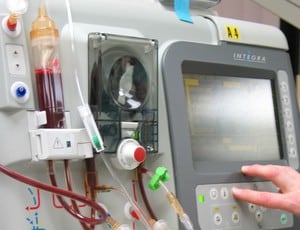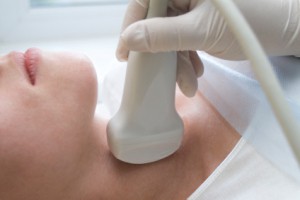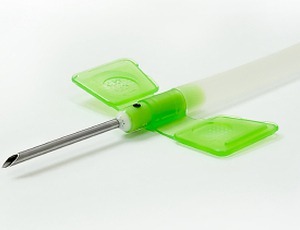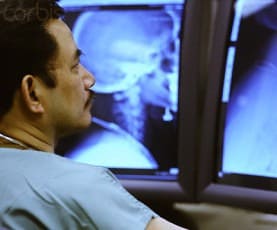Types and frequencies of complications associated with midline catheters and PICCs

The aim of this study was to describe the types and frequencies of complications of PICCs and midline catheters which were inserted by specialized registered nurses in a South Tyrolean district hospital” Kostner et al (2018). Abstract: Types and frequencies of complications associated with midline catheters and PICCs in a South Tyrolean district hospital: a […]
Novel short peripheral catheter design for prevention of thrombophlebitis

Here we introduce a novel SPC, named Very Short Peripheral Catheter(VSPC), that was designed to minimize biomechanical irritation and improve blood flow” Weiss et al (2018). Abstract: BACKGROUND: Short peripheral catheters (SPCs) are the most common intravenous device in today’s medical practice. Short peripheral catheter thrombophlebitis (SPCT) occurs in up to 80% of hospitalized patients. […]
Air embolism due to internal jugular vein catheterization

Air embolism due to internal jugular vein catheterization during procedural sedation is very rare, but it is a potentially life-threatening complication of central catheterization that warrants attention” Tosi et al (2018). Abstract: We performed a systematic review of the literature starting from a real case of venous air embolism (VAE) in a young infant undergoing […]
Crystalloids vs. colloids for fluid resuscitation in the intensive care unit

Crystalloids were less efficient than colloids at stabilizing resuscitation endpoints; guidance on when to switch is urgently required” Martin and Bassett (2018). Abstract: PURPOSE: Guidelines recommend crystalloids for fluid resuscitation in sepsis/shock and switching to albumin in cases where crystalloids are insufficient. We evaluated hemodynamic response to crystalloids/colloids in critically ill adults. MATERIALS AND METHODS: […]
Outcomes of vascular access in patients older than 70 years

The advantage of arteriovenous fistulas (AVFs) in older patients requiring dialysis is controversial. We reviewed our vascular access experience in patients ≥70 years of age (older group) compared with younger patients” Hwang et al (2018). Abstract: OBJECTIVE: The advantage of arteriovenous fistulas (AVFs) in older patients requiring dialysis is controversial. We reviewed our vascular access […]
Electronic-prescribing and infusion-related medication errors

This study aims to achieve consensus on defining as medication errors a range of either technology-generated, or previously unaddressed infusion-related scenarios, common in the paediatric intensive care setting” Howlett et al (2019). Abstract: BACKGROUND: The use of health information technology (HIT) to improve patient safety is widely advocated by governmental and safety agencies. Electronic-prescribing and […]
Needle insertion skill in central venous catheterization training

Training for ultrasound-guided central venous catheterization (CVC) is typically conducted on static manikin simulators with real-time feedback from a skilled observer. Dynamic haptic robotic trainers (DHRTs) are an alternative method that simulates various patient anatomies and provides consistent feedback for each insertion” Chen et al (2018). Abstract; BACKGROUND: Training for ultrasound-guided central venous catheterization (CVC) […]
Surgical treatment of patients with superior vena cava syndrome

Presented herein are two clinical case reports concerning surgical treatment for superior vena cava syndrome in patients suffering from end-stage renal disease and undergoing programmed haemodialysis” Maksimov et al (2018). Abstract: Presented herein are two clinical case reports concerning surgical treatment for superior vena cava syndrome in patients suffering from end-stage renal disease and undergoing […]
Risk of bleeding after ultrasound-guided jugular central venous catheter insertion

We sought to assess the incidence and risk factors of bleeding after ultrasound-guided internal jugular (USGIJ) catheter insertion in severely thrombocytopenic cancer patients, as safe platelet (PLT) count threshold remains controversial” AlRstum et al (2019). Abstract: INTRODUCTION: We sought to assess the incidence and risk factors of bleeding after ultrasound-guided internal jugular (USGIJ) catheter insertion […]
Evaluation of an intraosseous needle causing compartment syndrome

We present a case where point-of-care ultrasound was used to quickly identify a malfunctioning IO needle that resulted in compartment syndrome of the lower extremity” Abramson et al (2018). Abstract: Intraosseous (IO) needles are used in critically ill patients when it is not possible to quickly obtain venous access. While they allow for immediate access, […]
Intravenous catheter-related adverse events during OPAT

Drug-related adverse events (AEs) are reported to be common amongst patients receiving outpatient parenteral antimicrobial therapy (OPAT). However, comparative data regarding intravenous (iv) catheter-related AEs are lacking” Underwood et al (2018). Abstract: BACKGROUND: Drug-related adverse events (AEs) are reported to be common amongst patients receiving outpatient parenteral antimicrobial therapy (OPAT). However, comparative data regarding intravenous […]
Home environment hazards among OPAT patients

Outpatient parenteral antimicrobial therapy (OPAT) requires that patients and their caregivers administer antimicrobial medications in the home via venous catheters. Hazards from physical attributes of the home environment may impede safe performance of OPAT tasks” Keller et al (2018). Abstract: BACKGROUND: Outpatient parenteral antimicrobial therapy (OPAT) requires that patients and their caregivers administer antimicrobial medications […]
Development of paediatric OPAT services

There has been little detailed systematic consideration of the delivery, setting and outcomes of paediatric Outpatient Parenteral Antimicrobial Therapy (OPAT), although individual studies report that it is a safe and effective treatment” Carter et al (2018). Abstract: BACKGROUND: There has been little detailed systematic consideration of the delivery, setting and outcomes of paediatric Outpatient Parenteral […]
Standards of antibiotic stewardship in OPAT services

This narrative review aims to describe barriers of outpatient parenteral antimicrobial therapy at home (OPAT), potentially compromising general standards of antibiotic stewardship (ABS) and facilitators of OPAT for ABS” Steffens et al (2018). Abstract: PURPOSE: This narrative review aims to describe barriers of outpatient parenteral antimicrobial therapy at home (OPAT), potentially compromising general standards of […]
Role of infectious diseases expert team in OPAT services

To evaluate the added value of consultation of an infectious diseases expert team (consisting of two internist-infectious diseases specialists and a microbiologist) for advice regarding type, administration route and duration of antibiotic treatment” Wijnakker et al 92018). Abstract: Background: There is increasing interest in outpatient parenteral antimicrobial treatment. Objective: To evaluate the added value of […]
Central venous access with accelerated seldinger technique

In the simulated setting, the accelerated Seldinger technique using combination CVC devices is a faster and easier method for CVC placement compared to the modified Seldinger technique” Thaut et al 920180. Abstract: BACKGROUND: Central vein catheter (CVC) placement using the modified Seldinger technique is a common procedure in the emergency department, but can be time […]
Endovascular procedures for the treatment of vascular access stenosis and thrombosis

There is amassed evidence regarding the use of endovascular procedures for the treatment of vascular access stenosis and thrombosis” Kitrou et al (2018). Abstract: There is amassed evidence regarding the use of endovascular procedures for the treatment of vascular access stenosis and thrombosis. A review was conducted based on available randomized trials, cohort studies and […]
Optimal dialysis vascular access for the elderly

Conflicting data continue to surround the optimal dialysis access for the elderly. Many propose that catheters are the best option for this population; others emphasize the creation of an arteriovenous fistula” Asif et al (2018). Abstract: BACKGROUND: Conflicting data continue to surround the optimal dialysis access for the elderly. Many propose that catheters are the […]
Risk factors for complications in cancer patients with totally implantable access ports

To analyze the risk factors for complications associated with the use of totally implantable access ports (TIAPs) in cancer patients” Bademler et al (2018). Abstract: OBJECTIVES: To analyze the risk factors for complications associated with the use of totally implantable access ports (TIAPs) in cancer patients. METHODS: Data for 2,713 cancer patients who received a […]
Point-of-care ultrasound-guided AVF needle placement

This pilot and feasibility study will assess the feasibility of a randomised controlled trial aimed at evaluating whether POCUS-guided cannulation results in more successful and accurate AVF needle placement than the standard practice of blind cannulation” Schoch et al (2018). Abstract: BACKGROUND: Point-of-care ultrasound (POCUS) has been used in various vascular access contexts; however, to […]
OPAT for complicated Staphylococcus aureus infections

Patients discharged to SNFs may be at higher risk for line events than patients discharged to HHCs. Efforts should be made to strengthen basic OPAT processes, such as lab monitoring and clinic follow-up, at both sites of care” Townsend et al (2018). Abstract: BACKGROUND: In the United States, patients discharged on outpatient parenteral antimicrobial therapy […]
Antifungal therapy safety in the OPAT setting

We suggest that with appropriate patient selection, patients with fungal infections could successfully be treated on OPAT” Rae et al (2018). Abstract: Outpatient parenteral antimicrobial therapy (OPAT) is an established treatment option for patients with a variety of infections who require a period of intravenous therapy, are clinically stable, and do not require continuous monitoring. […]
Indications and complications of peripherally inserted central catheters

This review describes the indications, contraindications, methods of insertion and complications of PICC” Glauser et al (2018). Abstract: Peripherally inserted central catheter (PICC) can be used for short to medium-term administration of intravenous treatments. Their main advantages lie in their ease of insertion and removal, compared with other types of central venous access. Complications of […]
Overview of anti-thrombogenic peripherally inserted central catheters

A current innovation focus has been the development of anti-thrombogenic catheter materials, including hydrophilic and hydrophobic surfaces” Ullman et al (2018). Abstract: Thrombotic complications associated with peripherally inserted central catheters (PICCs) are common, as most synthetic materials when placed in the presence of serum often result in platelet activation, fibrin deposition, thrombotic occlusion and potentially […]
Physico-chemical stability of Plasma-Lyte 148 with common intravenous medications

To investigate the stability of Plasma-Lyte 148 ® and Plasma-Lyte 148 ® + 5% Glucose with eight commonly used therapeutic agents when compared with 5% Glucose and 0.9% Sodium Chloride as diluents” Dawson et al (2018). Abstract: BACKGROUND: Plasma-Lyte 148 ® is a balanced, crystalloid intravenous (IV) fluid which is both calcium-free and isotonic. It […]
Various vascular access devices in palliative care

A prospective, observational study was conducted in our palliative care unit to assess the impact of peripherally inserted central catheters (PICCs), midline, and “short” midline catheters on the quality of care in cancer and non-cancer patients” Magnani et al (2018). Abstract: OBJECTIVES: A prospective, observational study was conducted in our palliative care unit to assess […]
Comparison of different ultrasound techniques for jugular venous catheterization

Internal jugular venous catheterization (IJVC) is performed for numerous therapeutic interventions. Although ultrasound-guided IJVC is the gold standard for this procedure, complications can still occur” Chen et al (2018). Abstract: BACKGROUND: Internal jugular venous catheterization (IJVC) is performed for numerous therapeutic interventions. Although ultrasound-guided IJVC is the gold standard for this procedure, complications can still […]
Folded large-bore central catheter in the right internal jugular vein

Mechanical complications of central venous catheter insertion are well known, but folding of a large-bore catheter in the internal jugular vein has rarely been reported” Pyeon et al (2018). Abstract: Central venous catheters are used for various purposes in the operating room. Generally, the use of ultrasound to insert a central venous catheter is rapid […]
Blunt separation method during modified Seldinger PICC placement

To explore the application value of blunt separation method in the modified Seldinger technology peripherally inserted central catheter (PICC) catheterization in the hemopathic patients” Li et al (2018). Abstract: OBJECTIVE: To explore the application value of blunt separation method in the modified Seldinger technology peripherally inserted central catheter (PICC) catheterization in the hemopathic patients. METHODS: […]
Antiseptic efficacies of waterless hand rub, chlorhexidine scrub, and povidone-iodine scrub

The aim of this study was to conduct a systematic review and meta-analysis to compare the antiseptic efficacies of WHR, CHG, and PI in surgical settings” Ho et al (2018). Abstract: Background: Presurgical hand washing is crucial for preventing surgical site infections (SSIs). Chlorhexidine gluconate (CHG) and povidone-iodine (PI) products have been conventionally used as […]

